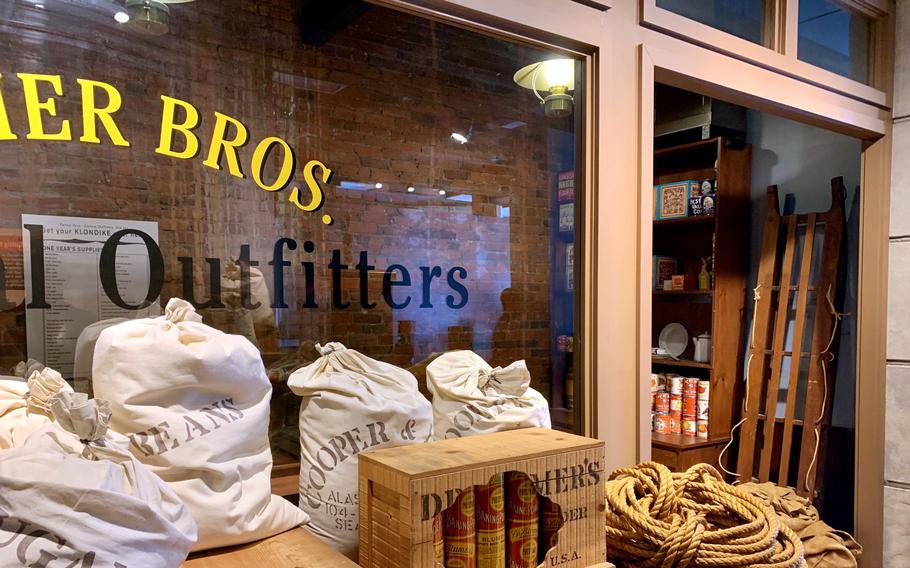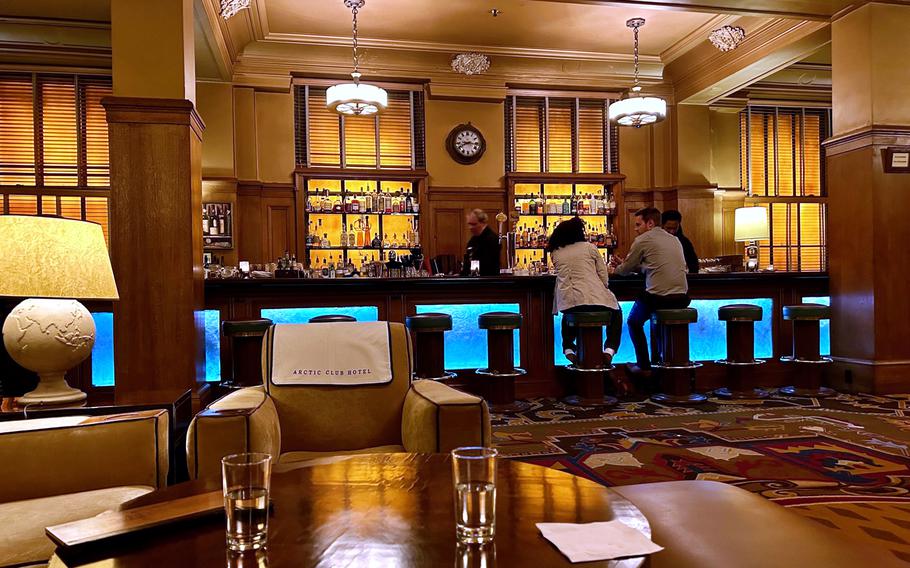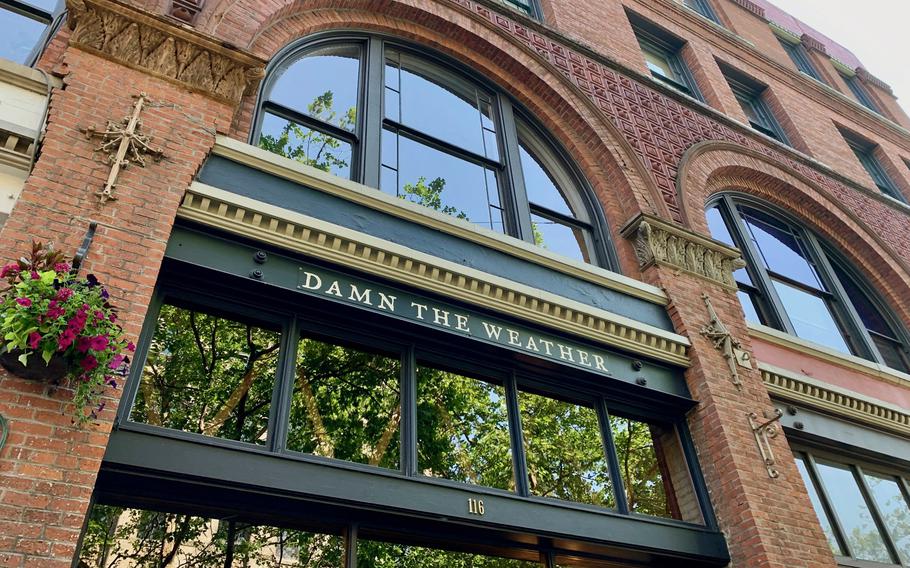
The Klondike Gold Rush National Historical Park visitors center in Seattle offers a glimpse of the past. Its museum’s two floors are filled with artifacts, photos and displays, including a re-created outfitter’s shop filled with canned goods, boots and other items from a truly jaw-dropping supply list. (Jackie Burrell, Bay Area News Group/TNS)
SEATTLE — It’s a rare weekend getaway that combines subterranean sidewalks, conflagrations and a Polar Bar, complete with glacier ice. Also walruses. A little Jules Verne. And the founder of Nordstrom.
Let me explain.
A century ago, private clubs devoted to scientific exploration were a thing — in real life, not just in Disney movies and “Around the World in 80 Days.” New York City’s Explorers Club opened in 1904, offering expedition support, as well as libraries, lounges and grand halls where intrepid explorers — the real-life Phileas Foggs of the world — could regale fellow members with their adventures in icy climes and jungles. Polar explorer Robert Peary’s New York club, the Peary Arctic Club, opened in 1898.
And on the West Coast, two Seattle tycoons launched their own Arctic Club, where Klondike Gold Rush stampeders could reminisce about their days in the gold fields. In 1916, it moved to a grand, new Beaux Arts building, an eight-story structure whose exterior was adorned with terra cotta walrus cartouches. Inside, there were guest rooms for members, a rooftop garden, a library, a bowling alley, a barbershop, billiard rooms, a ladies’ tea parlor and a spectacular domed dining room with an illuminated, stained-glass ceiling.
It was spectacular. It still is. Only now, it’s a well-appointed hotel run by the Oxford Collection, which purchased the property during the pandemic and reopened it last fall. Were it not for the complimentary WiFi and speedy Uber pickups, you’d swear you’d time-traveled to 1916.
Portraits by photographer and ethnologist Edward Curtis adorn the walls, some depicting original club members and others capturing the life and faces of the indigenous people of the Yukon Territory at the time of the gold rush. The hotel lobby is lined with Alaskan marble. There’s a display of dapper hats and starched collars —donated by members — by the front desk. And a giant translucent polar bear stands sentry at the Polar Bar, where bartenders shake up smoky, rye-spiked “I am the Walrus” cocktails ($18).

History runs deep at the Arctic Club Hotel in Seattle, where decor in the lobby and at the hotel’s Polar Bar give a nod to the late 19th-century Klondike Gold Rush and the argonauts who gathered afterward. (Jackie Burrell, Bay Area News Group/TNS)
You expect Fogg and Passpartout — or their Klondike-prospecting equivalents — to walk in at any moment, perhaps after strolling through historic Pioneer Square, where modern-day Seattle began.
Seattle’s first neighborhood is still recovering from the pandemic, but its rich history, jaw-dropping drama and 19th-century city planning decisions live on, along with memories of the gold rush that put this city on the map.
We Californians have our own 49ers lore on that score. But the Klondike Gold Rush, which sent 100,000 fortune-hunters stampeding northward in the late 1890s, is a tale of its own. Gold fever took hold so completely, even Seattle’s mayor bailed to go seek his fortune in the Yukon.
So on our first morning, having slept through breakfast at the hotel, we fuel up with lattes and lox-topped bagels at the cozy Cherry Street Coffee House just blocks from Klondike Gold Rush National Historical Park. The park has several sites in Skagway, Alaska, as well as a visitors center in Pioneer Square.
Why here? This was the “Gateway to the Gold Fields,” a name conjured up by Erastus Brainerd, a journalist and the head of the city’s chamber of commerce. Some 70,000 of those 100,000 Yukon-bound stampeders saw Brainerd’s newspaper ads and came through Seattle to buy their ton of equipment from Pioneer Square shopkeepers.
That’s not hyperbole, we discover at the visitors center. Canadian authorities were so worried that naive fortune seekers would starve to death in the wilderness, they made it a border entry requirement that every person carry enough supplies — roughly 2,000 pounds of food, clothing and gear — to survive a year in the icy Yukon. (We also learn that stampeders who made it through multiple winters were called “sourdoughs.”)
The museum is a delight. Its two floors are filled with artifacts, photos and displays, including a re-created outfitter’s shop filled with canned goods, boots and other items from a truly jaw-dropping supply list.
Stories abound — about C.C. Filson, for example, whose Pioneer Alaska Clothing and Blanket Manufacturers got its start equipping stampeders with sturdy boots, camping gear and distinctive jackets made from thick, water-repellent wool with four cargo pockets on the front. (Filson shops at Seattle airport and in San Francisco carry them for 21st century adventurers, by the way.) And then there’s John W. Nordstrom, who spent two years in the Yukon. After selling his claim for $13,000, he went to business school and then launched a Seattle shoe store with a partner, starting a business that would eventually become a department store empire.
And then there are the historic photographs, including images of the Golden Staircase, an icy near-vertical trail — with a 1,000-foot elevation gain in the last half mile — at Chilkoot Pass that prospectors had to traverse not once but over and over and over, as they carried their ton of equipment to the top, 50 to 75 pounds at a time.
Afterward, we stop in at Damn the Weather — best name ever for a Seattle bar — for a charcuterie-style bite ($22) and a bit of research as we enjoy the cozy ambience of this century-old building, with its exposed brick walls.

Seattle’s Damn the Weather offers craft cocktails and small bites in the Pioneer Square district. (Jackie Burrell, Bay Area News Group/TNS)
We Google as we nibble, curious about the historic former Cadillac Hotel, which houses the national park center. Soon, we’re down a rabbit hole, immersed in tales from the Great Seattle Fire of 1889, which destroyed the city’s entire 25-block business district. Some 465 brick and stone buildings, including the Cadillac, were built the year following the fire, but we want to know more about what happened on June 6, 1889.
In the lobby of Beneath the Streets, a floor below sidewalk level, Seattle actor and longtime tour guide Jim Gall tells the tale to our rapt group, which includes tourists from across the country.
On that balmy spring day, Gall says, an assistant at Victor Clairmont’s woodworking shop at what is now 909 First Ave. was melting glue over an open flame. When the glue boiled over and ignited, young John Back panicked and threw a bucket of water on the flames and —
The entire group gasps in horror. Parents whisper to their wide-eyed kids, “Never throw water on a grease fire!”
The flames spread swiftly to a liquor store, which exploded, and then two saloons before it spread to other businesses, the opera house, the mills, the wharves. Water pressure fell, fire hoses began failing and attempts to pump water from Elliott Bay at low tide didn’t help — the distance between waterline and flames were too great. Less than two hours after the fire began, the entire city was at risk. By 3 a.m., 120 acres had been destroyed.
At 11 a.m. the next morning, city officials and 600 business leaders met to begin rebuilding — and to fix some of the problems that afflicted the original Pioneer Square neighborhood. Construction would involve bricks, not wood. The city took over the water supply, adding hydrants and ensuring water pipes not be made of wood (yes, some were, and they had burned). And the streets, which flooded at high tide, would be raised up to 22 feet.
Buildings were rapidly reconstructed on the ruins of their predecessors, with their doors, first floors and sidewalks built at what would eventually be street level. But until that happened, if you wanted to cross the street, you had to clamber down a ladder, cross the old street and climb another ladder to reach the sidewalk on the other side. It wasn’t the Chilkoot Pass’ Golden Staircase, but it was challenging.
But the sidewalks and first floors of Old Seattle still exist beneath the streets, and there are vestiges in the most unexpected places. At Gall’s suggestion, we stopped in at Magic Mouse Toys, a bustling toy shop at 603 First Ave., and went downstairs. There’s a room with board games. Look up and you’ll see glass cubes in the ceiling, with rays of dim sunlight streaming through. You’re beneath the streets.
If you go
The Arctic Club Hotel: Rooms start in the $250 range, plus a $25 destination fee. 700 Third Ave., Seattle; www.arcticclubhotel.com
Cherry Street Coffee House: Opens at 7 a.m. weekdays and 8 p.m. on weekends at 700 First Ave.; www.cherryst.com
Klondike Gold Rush National Historical Park: Admission is free at the Seattle visitors center, which is open from 10 a.m. to 5 p.m. Wednesday through Sunday at 319 Second Ave. South; www.nps.gov/klse/
Damn the Weather: Opens at 11 a.m. daily at 116 First Ave. South; https://damntheweather.com
Beneath the Streets: Open daily for tours ($6-$29) at 102 Cherry St.; www.beneath-the-streets.com